|
The Wearable Technology Designer's Web Tool is a tool that leads designers / developers through a series of questions about their wearable technology project. The questions are designed to force designers to think of all options at the beginning of a project, illuminating opportunities and shortcomings in accessibility caused by decisions along the way. |
Visualizing sets to reveal relationships between constituent elements is a complex representational problem. Recent research presents several automated placement and grouping techniques to highlight connections between set elements. However, these techniques do not scale well for sets with cardinality greater than one hundred elements. We present OnSet, an interactive, scalable visualization technique for representing large-scale binary set data. |
The AEL has been preparing and pioneering this idea for ten years with our custom browser, Argon. Drawing on this background, we are now transitioning to the use of open-source technology such as A-frame and the Mozilla browser, WebXR viewer.  |
This project explores the concept of hyperspatial navigation by using the WebXR prototype RealityMedia 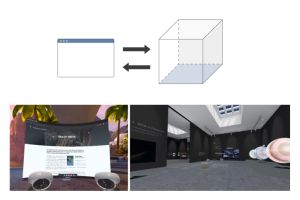 Website: |
|
A few Fridays ago, the Public Design Workshop (PDW) led a Design and Policy Jam with the Westside Atlanta Land Trust (WALT) Program. WALT's mission is “to organize the community's power for self-determination; to serve and preserve in-place residents, small business owners, and their successive generations in redeveloping areas.” The jam session supported this mission by tasking participants with researching and producing an argument for a city-wide community land trust (CLT) policy. 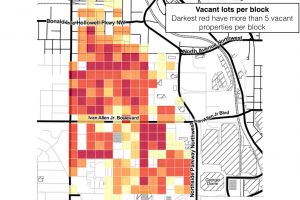 |
Westside Soul is an interactive installation that was displayed at the Historic Westside Cultural Arts Council's Black History Month Celebration. The installation displays videos of westside residents discussing issues in their community and allows viewers to add new responses through text and video. The installation is part of on ongoing partnership with the westside to explore the use of mobile and social computing and digital media to connect community members and instigate alternate forms of civic engagement.  |
The news is the source citizens turn to in order to gain accurate information about the current events of the world. Unfortunately, a large number of trusted news sources are the worst perpetrators of bias; effectively skewing the public's perception of important material. "Who Told it How" is a web-based interactive visualization that displays various elements of the Wendy Davis abortion filibuster, as written in articles by four major news syndicates, in order to expose bias and provide perspective. 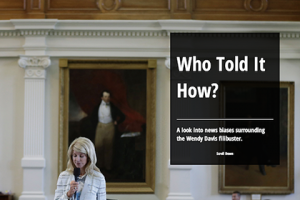 |
|
|
Our project on the human rights of Indian farmers. It is estimated that more than a quarter of a million Indian farmers have committed suicide in the last 16 years—the largest wave of recorded suicides in human history. By immersing the user in a rural farm in India, our goal is to foster understanding reinforced by dramatically motivated actions to express the dire living conditions and desperation of the farmers and their families. |
Exploration in using the sensation of wind as a computation interface and calm technology. |
A virtual reality experience in a dystopian world. With Love, Thunderbird is the story of a woman, nick-named Thunderbird, Peter and the struggles they face living in a society ruined by an unsuccessful coup and a string of useless ‘presidents’ who only accomplished increasing the inflation and unemployment rates. You play as Peter, navigating your way through this new world with your small robotic bird guide, with one simple goal: get medicine for Thunderbird. 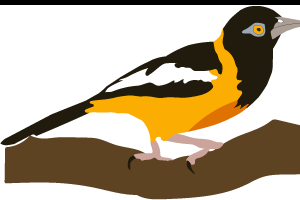 |
We present a qualitative inquiry through the lens of feminist human-computer interaction (HCI) into women's perceptions of personal safety in New Delhi, India. Since a brutal gang-rape incident in December 2012 that received global attention, the Indian government has issued a mandate to implement a panic button on every new phone by 2017. We draw on interview and survey data to examine women's reactions to the mandate as well as what factors influence their perceptions of safety, both positively and negatively. |
|
Procedural instructions and worked examples have been shown to be effective learning aids in science, technology, engineering, and mathematics (STEM) learning materials. Procedural instructions are texts that describe a general method to reach a goal, while worked examples demonstrate how to apply this method to a specific instance. Research supporting the use of advanced organizers predicts that if learners see the worked example first, they can develop a basis for the problem-solving procedure. 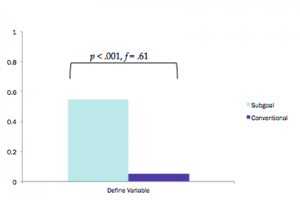 |
Passive sensing can potentially enabled future AI systems to provide algorithmic estimates of a worker's performance and wellbeing. However, left unchecked, such systems can worsen the power asymmetries at work. In this project, we aim to explore implementations of these systems that not only protect but also empower workers. |
Washing hands is one of the easiest yet most effective ways to prevent spreading illnesses and diseases. However, not adhering to thorough handwashing routines is a substantial problem worldwide. For example, in hospital operations lack of hygiene leads to healthcare associated infections. We present WristWash, a wrist-worn sensing platform that integrates an inertial measurement unit and a Hidden Markov Model-based analysis method that enables automated assessments of handwashing routines according to recommendations provided by the World Health Organization (WHO). |


